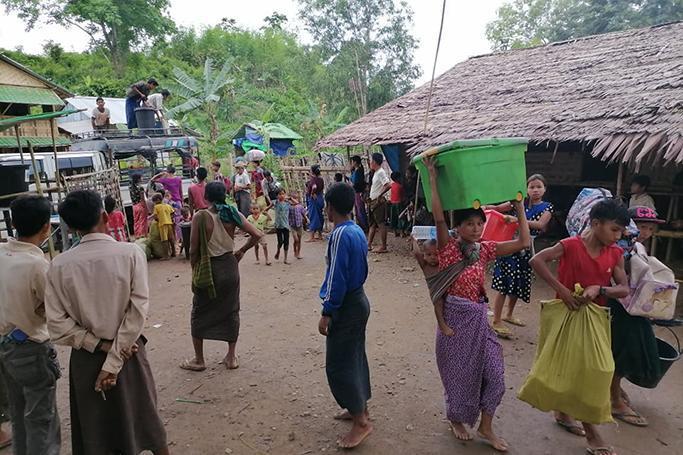For many years prior to the coup Myanmar Army activities in ethnic areas had caused people to flee their homes, but since the coup this has been happening more and for the first time it is also happening in the central, non-ethnic Bamar regions, according to the latest statistics from the UNHCR.
Most of the people who are forced to leave their homes by conflict or repression move elsewhere within Myanmar. These people are known as internally displaced people (IDPs). There are also those that escape to another country who are too fearful to return, these are known as refugees.
Ever since Burma independence in 1948 there have been conflicts in ethnic areas. These increased after the breaking of the Panglong Agreement that would have given ethnic areas the chance to choose autonomy but then there was the military coup of 1962 that bought General Ne Win to power. The fighting in ethnic created IDPs and refugees, the majority of whom fled to Thailand.
Over the decades, the numbers of IDPs and refugees have fluctuated depending on the Tatmadaw’s (Myanmar Army) brutality. For instance, whenever the army implemented its “four cuts” policy more people would be forced to flee.
Pya Ley Pya, or the 'four cuts' doctrine was adapted from the way the British dealt with the Malayan emergency and was adopted by the Tatmadaw after 1968. It aims to deny insurgents their key resources of funding, food, intelligence, and recruits.
To do this Naw Htoo Htoo of the Karen Human Rights Group describing how the Tatmadaw carried out the four cuts policy in Karen State said: “They targeted every person and village which they thought would have ties with the KNU… They fired indiscriminately at Karen villages, destroyed every food and aid item they thought was meant to support the KNU…restricted medical aid in conflict-affected areas, arrested people they suspected of providing aid and food, and arrested their family members…They also used widespread sexual violence and forcibly relocated entire communities.”
Villagers were frequently relocated by force and made to porter for the army. Wherever this Myanmar military policy was enacted it created more IDPs and refugees.
It was first used against the Karen in 1968 and has been used periodically since then, including between 1996 and 1998 in Shan State, in Kachin State since 2011, and more recently against the Muslim Rohingya in Rakhine State.
Until the coup in 2021 the Tatmadaw did not use such techniques against the Bamar population in the central regions, but that has all changed since the coup and the army has started treating the civilian population in those areas in the same way it has been treating them in ethnic areas.
Now the army is not just driving people from ethnic areas out of their homes, it is forcing people to flee their homes all across the country. Now, areas that previously had no IDPs are facing an IDP crisis.
The region where most IDPs have been created is Sagaing Region. Before the coup there were no IDPs in Sagaing Region, now there are 195,300 IDPs, more than in any other region or state, except for Rakhine State where persecution of the Rohingya meant there was 223,100 IDPs. Though, because of an informal 2020 ceasefire between the junta and the Arakan Army (AA), an ethnic armed organisation (EAO) operating in Rakhine and Chin states, and because the Tatmadaw wants to concentrate on suppressing rebels in other areas, no new IDPs have been created in Rakhine since the coup. It is the only state or region where IDP numbers have not risen since the coup.
Other areas that had no IDPs before the coup and the number of IDPs they now have are as follows: Kayah (Karenni) State, 92,900 IDPs; southern Shan State, 57,100 IDPs, Magway Region, 44,300 IDPs; Mon State, 7,600 IDPs; and Tanintharyi Region, 3,700 IDPs.
More IDPs have been created since the coup in Sagaing Region, Kayah State, southern Shan State, and Magway Region than in any other state that previously had IDPs apart from Karen State where 75,500 IDPs have been created since the coup to add to the 14,000 IDPs who were in the state before the coup. This increase of 539 per cent that means there are now 89,500 IDPs in Karen State.
Except for Rakhine IDP numbers in all areas where there were previously IDPs have gone up since the coup.
Apart from Karen State, other areas where the number of IDPs increased are as follows:
In Chin State before the coup there were 6,300 IDPs, now there are 33,300, an increase of 528 per cent, meaning there are now 39,600 IDPs in Chin State.
In northern Shan State since the coup an extra 6,700 IDPs have been created to add to the 9,500 who were there before the coup. An increase of 70 per cent making a current total of 16,200 IDPs.
In Kachin State there have been an extra 3,900 IDPs created since the coup, an increase of 4 per cent on the 92,500 IDPs in the state prior to the coup, making for a current total of 96,400 IDPs in Kachin State.
Interestingly, the areas that had the most IDPs before the coup, Rakhine and Kachin States, have had some of the smallest increases in IDP numbers since the coup.
In Karen (Kayin) State before the coup there were 14,000 IDPs. Since the coup there have been an extra 75,500 IDPs, an increase of 539 per cent.
Source: All IDP and refugee numbers for this article were taken from UNHCR.












